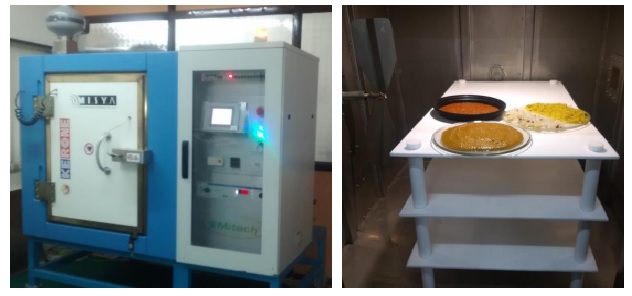Microwaves (MWs) are electromagnetic (EM) waves, that are synchronized perpendicularly oscillations of electrical and magnetic fields that propagate at the speed of light during a free space. MWs are characterised by the frequency (between three hundred MHz and three hundred GHz) and therefore the wavelength (ranging from 1 m to 1 mm). According to the countries and regions, 5 frequencies (433, 896, 915, 2375, and 2450 MHz) are approved for MW heating operations. The 2450 MHz is the exclusive frequency for home appliances.

The interaction of a wave with the material depends on its own characteristics (frequencies, wavelength) and the nature of the material, particularly its absolute permittivity ε*, a complex number that determines how the material stores the electrical energy of the EF and its dissipation into heat. We can define rapidly here the real permittivity, or dielectric constant, of a material which denotes the capacity of the material to store electrical energy and the effective loss factor which expresses the ability of the material to absorb energy of the wave and dissipate it into the heat by dielectric relaxation and ionic conduction. If a material contains free charges (ions) and polar molecules (e.g., water molecule) when this material is subjected to an EF, the ions will move at an accelerated rate according to their charge, which will cause collisions between them and, by the result, a conversion of the kinetic energy into heat (ohmic heating). In the same way, the polar molecules of this material, which was initially randomly oriented, will be oriented according to the polarity of the field. If the EF is an alternative, these molecules will rotate to remain aligned on it. This dipolar rotation will generate frictions between the molecules which will lead to an internal generation of heat (dielectric heating).
Drying is one among the most used ways for preserving food and preventing microbiological degradation. Food drying is additionally used for economic interests by lightening the product to reduce the transport costs (e.g., milk powder) or maybe for consumption aspects by making new textures and/or product (e.g., prunes). This method aims to reduce the water activity (Aw) of the food product by removing some of its water. The quantity of water to be removed to attain the microbiological stability may be determined because of the sorption isotherm curve that shows the connection between the water content and the water activity of a product.
Despite its many advantages over the standard ways, MW drying has some crucial issues. However, MW drying combined with different conventional heating methods enhances the drying potency as well as the dried product quality compared to MW drying alone. Applications of combined MW drying, principally, contains MW-assisted hot air (HA) drying, MW vacuum drying, and MW freeze drying.
In general, coupling MW heating with other heating ways mostly improved the microbiological safety, the drying potency, and therefore the quality of various food products. Physical modelling and simulation are vital tools to know and to optimize MW heating processes. The application of those models is limited in industrial scale; but, experimental design-based approaches might be promising ways. Even so, developing a reliable industrial MW heating method continues to be a challenge.
We at KERONE have a team of experts to help you with your need for Microwave Heating Systems in various products range from our wide experience.
